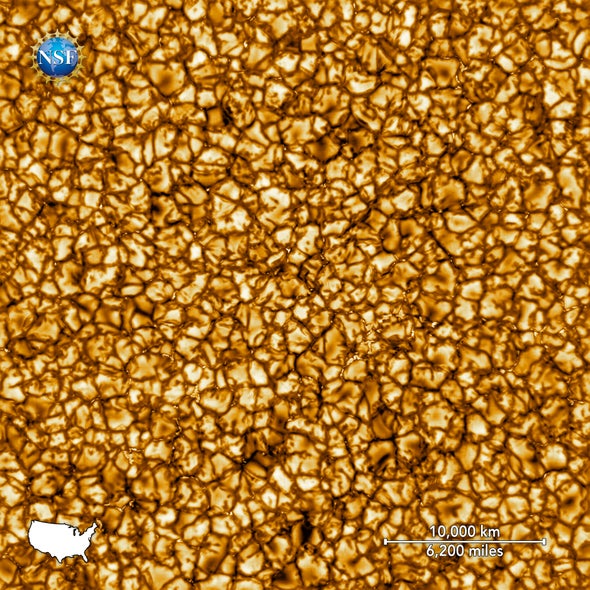Scientists have released the first pictures from a new telescope in Hawaii, one of three missions expected to redefine our understanding of our home star in the 2020s
Why is the sun’s outer atmosphere so much hotter than its surface? What drives its 11-year cycle of magnetic activity? And how does its solar wind propagate out into the solar system? Scientists hope to answer all these questions and more in the coming decade, thanks to an armada of new missions that will scrutinize the sun in more detail than ever before. With the debut of two unprecedented spacecraft and the largest ground-based solar observatory ever built, research into our home star is set to reach new heights.
One of the two spacecraft has already launched: NASA’s Parker Solar Probe, which soared skyward on August 12, 2018. Designed to approach our star within just 4 percent of the Earth-sun distance, or 0.04 astronomical units (AU), it is the closest mission ever sent to our star. The other craft, the European Space Agency’s (ESA’s) Solar Orbiter mission, is scheduled to lift off from Cape Canaveral, Fla., on February 7. Although projected to only reach 0.28 AU, this mission will capture some of the most detailed images of the sun ever seen, including the first pictures of its poles. And today scientists released inaugural images from the four-meter Daniel K. Inouye Solar Telescope (DKIST) on Maui in Hawaii. Run by the National Science Foundation in the U.S., these are the most detailed images ever taken of the solar surface.
“It’s extremely exciting to be a solar physicist at this point in time, with all of these missions,” says Thomas Rimmele, an astronomer and project director of DKIST at the National Solar Observatory.“With just the first images [from DKIST], you see detail that we’ve never seen before. And this is really just the beginning.”
DKIST’s five instruments are designed to both image the sun and probe its magnetic field, allowing scientists to discern the field’s strength and orientation. Scientists hope to use these data to help resolve the long-standing mystery of why the sun’s corona—its halolike outer atmosphere—is up to millions of degrees hotter than its surface. Data from DKIST will also allow researchers to probe the magnetic fields of the vast structures that arc and loop between these two regions.
Complementing DKIST are the aforementioned Parker Solar Probe and Solar Orbiter. By repeatedly flying close to the sun over the next five years at record-setting speeds of nearly 700,000 kilometers per hour, the former will be able to measure pristine material ejected from our star, and it is already providing invaluable data from its early passes. “Parker Solar Probe is showing us signatures of the solar wind and the plasma in the corona that we’ve never seen before in previous missions,” says Nour Raouafi, project scientist for the probe at the Johns Hopkins University Applied Physics Laboratory.
Meanwhile the Solar Orbiter has the capability to directly image the sun from its close-up vantage point—something the Parker Solar Probe lacks. Poking through small holes in the spacecraft’s titanium heat shield, cameras will provide the closest images of the sun ever taken. Beyond the delivery of such stunning snapshots, scientists are already excited about other insights this mission might reveal, such as how our star launches flares and coronal mass ejections—“space weather” events that can severely disrupt global power grids and telecommunications. “The main problem with space weather at the moment is [we have] a 12-hour warning at most,” says Stephanie Yardley, a solar physicist at the University of St. Andrews in Scotland. “If we [know] the evolution of the magnetic field of the sun and the solar atmosphere, we can gain some insight into how these eruptions are actually formed. It’s currently very difficult [to predict them].”
The Solar Orbiter has one more trick up its sleeve, too. It will use repeated encounters with Venus to gradually raise the inclination of its orbit, eventually reaching 33 degrees above the plane of the planets if, as hoped, the mission is extended beyond its initial seven years. Doing so will enable it to orbit the sun at a high angle, capturing images of the sun’s poles. “We’re hoping to see how the magnetic field on the surface migrates toward the poles and eventually influences the ‘flip’ of the sun’s poles [every 11 years],” Yardley says.
Numerous sun-observing spacecraft have been launched before but without the advanced capabilities of these new missions. ESA and NASA’s widely regarded and still operational Solar and Heliospheric Observatory (SOHO) launched in 1995, but it only sits at a distant 0.99 AU from the sun. The German-U.S. Helios probes in the 1970s, meanwhile, set the previous record for the closest approach to the sun of 0.29 AU, yet they have since been eclipsed by the Parker Solar Probe. And ESA and NASA’s Ulysses spacecraft used a gravitational assist from Jupiter to fly over the sun’s poles in the mid-1990s and early 2000s, but it did so without cameras to image what they looked like.
Together, Raouafi says, these new missions herald an upcoming “golden age” of solar studies. “They have the potential to define the future direction of solar and heliophysics research,” he says. And Gregory Fleishman of the New Jersey Institute of Technology hopes they might inspire even more projects in the near future. He is currently part of a team seeking funding for a new large solar radio telescope after having just used a more modest array to probe eruptions of magnetic fields on the sun. “The golden age would mean the measurements are [across] all wavelengths,” Fleishman says. “One important range is entirely missing: the radio range, which is unique because it’s the only window where we can measure the dynamic coronal magnetic fields.”
For scientists that have longed to answer some of the sun’s most intriguing questions, however, there has never been a better time to unearth its secrets. With the Parker Solar Probe expected to study the sun until 2025, the Solar Orbiter lasting until 2030 if its mission is extended, and DKIST potentially observing for decades to come, solar physicists such as Yardley are thrilled at what the future holds for our understanding. “We’re going to have these three different [missions] to provide us with all these different observations, the likes of which we’ve never had before,” she says. “Hopefully [they] can answer some of these big unanswered questions we have in solar physics at the moment.”
Source: scientificamerican.com













